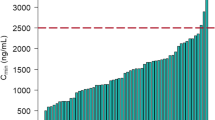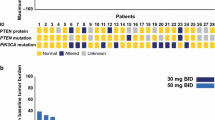Abstract
Introduction
The PARP inhibitor olaparib is efficacious as monotherapy and has potential application in combination with endocrine therapy for the treatment of breast cancer. This phase I study assessed the safety and pharmacokinetic (PK) profiles of olaparib combined with tamoxifen, anastrozole or letrozole in patients with advanced solid tumours.
Methods
During part A, PK profiles were assessed in three consecutive treatment periods: (1) olaparib (tablet) 300 mg bid, days 1–5 followed by a 4-day washout; (2) cohort 1, tamoxifen 60 mg loading dose qd days 10–13, 20 mg qd days 14–26; cohort 2, anastrozole 1 mg qd days 10–19; cohort 3, letrozole 2.5 mg qd days 10–38; (3) as for period 2, with concomitant olaparib 300 mg bid for 5 days. Patients could then enter part B and receive olaparib monotherapy (300 mg bid continuously). Safety was assessed in parts A and B until 12 months after the last patient entered part B.
Results
Seventy-nine patients (20.3% with breast cancer) received treatment in part A; 72 completed part A and 69 entered part B. Anastrozole and letrozole had no effect on the PK profile of olaparib and vice versa. Co-administration with tamoxifen produced a modest decrease in exposure to olaparib [geometric least-squares mean (GLSmean) Cmax,ss and AUC0–τ decreased by 20% (90% CI 0.71–0.90) and 27% (0.63–0.84), respectively]. Exposure to tamoxifen was slightly increased when combined with olaparib [GLSmean Cmax,ss and AUC0–τ increased by 13% (1.06–1.22) and 16% (1.11–1.21), respectively]; however, the 90% CI fell within the 0.7–1.43 boundary and there were no changes in exposure to tamoxifen metabolites. The safety profile for olaparib alone and in combination with the antihormonal therapies was acceptable.
Conclusions
The combination of olaparib and either anastrozole, letrozole or tamoxifen was generally well tolerated, with no clinically relevant PK interactions identified.
Funding
AstraZeneca.
Clinical Trial Registration
NCT02093351.



Similar content being viewed by others
References
Bryant HE, Schultz N, Thomas HD, et al. Specific killing of BRCA2-deficient tumours with inhibitors of poly(ADP-ribose) polymerase. Nature. 2005;434:913–7.
Farmer H, McCabe N, Lord CJ, et al. Targeting the DNA repair defect in BRCA mutant cells as a therapeutic strategy. Nature. 2005;434:917–21.
Fong PC, Boss DS, Yap TA, et al. Inhibition of poly(ADP-ribose) polymerase in tumors from BRCA mutation carriers. N Engl J Med. 2009;361:123–34.
Evers B, Drost R, Schut E, et al. Selective inhibition of BRCA2-deficient mammary tumor cell growth by AZD2281 and cisplatin. Clin Cancer Res. 2008;14:3916–25.
Rottenberg S, Jaspers JE, Kersbergen A, et al. High sensitivity of BRCA1-deficient mammary tumors to the PARP inhibitor AZD2281 alone and in combination with platinum drugs. Proc Natl Acad Sci USA. 2008;105:17079–84.
Kaufman B, Shapira-Frommer R, Schmutzler RK, et al. Olaparib monotherapy in patients with advanced cancer and a germ-line BRCA1/2 mutation. J Clin Oncol. 2015;33:244–50.
Ledermann J, Harter P, Gourley C, et al. Olaparib maintenance therapy in platinum-sensitive relapsed ovarian cancer. N Engl J Med. 2012;366:1382–92.
Pujade-Lauraine E, Ledermann JA, Selle F, et al. Olaparib tablets as maintenance therapy in patients with platinum-sensitive, relapsed ovarian cancer and a BRCA1/2 mutation (SOLO2/ENGOT-Ov21): a double-blind, randomised, placebo-controlled, phase 3 trial. Lancet Oncol. 2017;18:1274–84.
FDA. Lynparza prescribing information (2017 update). 2014. https://www.accessdata.fda.gov/drugsatfda_docs/label/2017/208558s000lbl.pdf. Accessed 3 July 2018.
Robson M, Im SA, Senkus E, et al. Olaparib for metastatic breast cancer in patients with a germline BRCA mutation. N Engl J Med. 2017;377:523–33.
National Comprehensive Cancer Network (NCCN). Clinical practice guidelines in oncology—breast cancer (version 2). 2016. https://www.nccn.org/professionals/physician_gls/f_guidelines.asp. Accessed 19 Oct 2017.
Femara® Summary of product characteristics. 2015. https://www.medicines.org.uk/emc/medicine/1285. Accessed: 19 Oct 2017.
Tamoxifen 20 mg tablets summary of product characteristics. 2015. https://www.medicines.org.uk/emc/medicine/30769. Accessed 19 Oct 2017.
AstraZeneca. Arimidex® summary of product characteristics. 2014. https://www.medicines.org.uk/emc/medicine/3845. Accessed 19 Oct 2017.
AstraZeneca. Global policy: bioethics. 2016. https://www.astrazeneca.com/content/dam/az/PDF/Bioethics_policy.pdf. Accessed 8 July 2016.
European Medicines Agency. Guideline on bioanalytical method validation. 2011. http://www.ema.europa.eu/docs/en_GB/document_library/Scientific_guideline/2011/08/WC500109686.pdf. Accessed 19 Oct 2017.
FDA. Guidance for industry: bioanalytical method validation. 2001. https://www.fda.gov/downloads/Drugs/GuidanceComplianceRegulatoryInformation/Guidances/ucm070107.pdf. Accessed 19 Oct 2017.
Rolfo C, Swaisland H, Leunen K, et al. Effect of food on the pharmacokinetics of olaparib after oral dosing of the capsule formulation in patients with advanced solid tumors. Adv Ther. 2015;32:510–22.
Plummer R, Swaisland H, Leunen K, et al. Olaparib tablet formulation: effect of food on the pharmacokinetics after oral dosing in patients with advanced solid tumours. Cancer Chemother Pharmacol. 2015;76:723–9.
Dirix L, Swaisland H, Verheul HMW, et al. Effect of itraconazole and rifampin on the pharmacokinetics of olaparib in patients with advanced solid tumors: results of two phase I open-label studies. Clin Ther. 2016;38:2286–99.
Mateo J, Moreno V, Gupta A, et al. An adaptive study to determine the optimal dose of the tablet formulation of the PARP inhibitor olaparib. Target Oncol. 2016;11:401–15.
Sane RS, Buckley DJ, Buckley AR, Nallani SC, Desai PB. Role of human pregnane X receptor in tamoxifen- and 4-hydroxytamoxifen-mediated CYP3A4 induction in primary human hepatocytes and LS174T cells. Drug Metab Dispos. 2008;36:946–54.
AstraZeneca. Lynparza. Summary of product characteristics. 2016. https://www.medicines.org.uk/emc/medicine/30359. Accessed 17 Nov 2016.
Kamdem LK, Liu Y, Stearns V, et al. In vitro and in vivo oxidative metabolism and glucuronidation of anastrozole. Br J Clin Pharmacol. 2010;70:854–69.
Ledermann JA, Harter P, Gourley C, et al. Overall survival in patients with platinum-sensitive recurrent serous ovarian cancer receiving olaparib maintenance monotherapy: an updated analysis from a randomised, placebo-controlled, double-blind, phase 2 trial. Lancet Oncol. 2016;17:1579–89.
Malmgren JA, Calip GS, Pyott SM, Atwood MK, Kaplan HG. Therapy-related myelodysplastic syndrome following primary breast cancer. Leuk Res. 2016;47:178–84.
Cardoso F, Costa A, Senkus E, et al. 3rd ESO-ESMO international consensus guidelines for advanced breast cancer (ABC 3). Breast. 2017;31:244–59.
Acknowledgements
The authors would like to thank the patients who took part in the study and Dr. Marlies Langenberg, UMC Utrecht, for her contribution as a trial investigator.
Funding
This study was sponsored by AstraZeneca and is part of an alliance between AstraZeneca and Merck & Co., Inc. Article processing charges and the Open Access fee were also funded by AstraZeneca and Merck & Co., Inc. All authors had full access to all of the data in this study and take complete responsibility for the integrity of the data and accuracy of the data analysis.
Medical Writing and other Editorial Assistance
Medical writing assistance was provided by Lizzie Wilkins PhD, of Mudskipper Business Ltd, funded by AstraZeneca and Merck and Co, Inc. The UK centres involved were Experimental Cancer Medicine Centres supported by Cancer Research UK and the Department of Health.
Authorship
All named authors meet the International Committee of Medical Journal Editors (ICMJE) criteria for authorship for this manuscript, take responsibility for the integrity of the work as a whole, and have given final approval of the version to be published.
Disclosures
Christian Rolfo has received research grants from OncoDNA, honoraria from Mylan and speakers’ fees from MSD, Novartis and Guardant Health. Their current affiliation is University of Maryland Marlene and Stewart Greenebaum Comprehensive Cancer Center, Baltimore, MD, USA. Jacques De Grève has received travel grants from AstraZeneca. Guy Jerusalem has received investigator fees to his institution from AstraZeneca and grants and personal fees from Novartis, Roche, Pfizer, Lilly, Celgene, Amgen, BMS, Puma and Daiichi Sankyo. Carsten Goessl is an employee of AstraZeneca and owns stock. Maria Learoyd is an employee of AstraZeneca and owns stock. Christopher Bailey is an employee of AstraZeneca and owns stock. Joseph Birkett has received consulting fees from AstraZeneca, their current affiliation is Crest Pharma Ltd, Surrey, UK. Stuart Spencer is an employee of Plus-Project contracted to AstraZeneca and owns shares in AstraZeneca. At the time of the study Emma Dean worked at The Christie NHS Foundation Trust, the University of Manchester, Manchester, UK. Since completion of this study, Emma Dean has taken up employment with AstraZeneca and owns stock. At the time of the study, Rhoda Molife worked for The Royal Marsden and Institute of Cancer Research, Sutton, UK. Their current affiliation is MSD, London, UK. Ruth Plummer, Henk Verheul, Filip De Vos, Karin Leunen, Peter Grundtvig-Sørensen, Sylvie Rottey, Antoine Italiano, James Spicer and Luc Dirix have nothing to disclose.
Compliance with Ethics Guidelines
The institutional review boards or independent ethics committees of all investigational sites approved the protocol. All procedures performed in studies involving human participants were in accordance with the ethical standards of the institutional and/or national research committee, the 1964 Helsinki declaration and its later amendments or comparable ethical standards, Good Clinical Practice, and the AstraZeneca policy on bioethics. Informed consent was obtained from all individual participants included in the study.
Author information
Authors and Affiliations
Corresponding author
Additional information
Enhanced digital features
To view enhanced digital features for this article go to https://doi.org/10.6084/m9.figshare.7146524.
Rights and permissions
About this article
Cite this article
Plummer, R., Verheul, H.M., De Vos, F.Y.F.L. et al. Pharmacokinetic Effects and Safety of Olaparib Administered with Endocrine Therapy: A Phase I Study in Patients with Advanced Solid Tumours. Adv Ther 35, 1945–1964 (2018). https://doi.org/10.1007/s12325-018-0804-z
Received:
Published:
Issue Date:
DOI: https://doi.org/10.1007/s12325-018-0804-z




